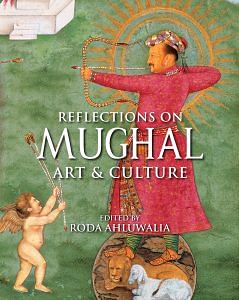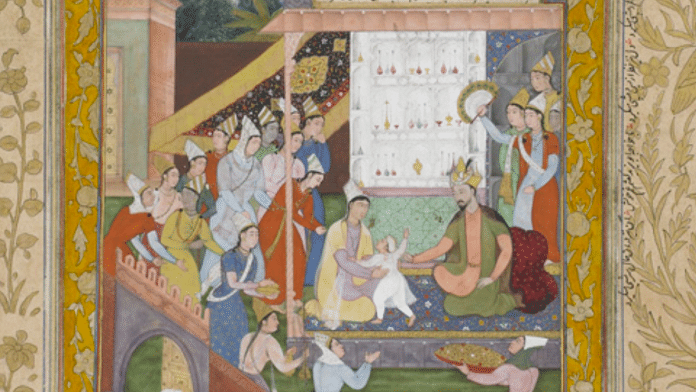In this essay, I focus on representations of two elite Mughal women: Mahim Anaga (d. 1562), who served as Emperor Akbar’s advisor, and Hamida Banu (d. 1604), who was Emperor Humayun’s wife, Akbar’s mother and his right-hand advisor in matters of state. I argue that the portrayal of these Mughal women in illustrated court histories, such as the Akbarnama and Jahangirnama, is not different from the representation of Mughal men in the same illustrations. This visual evidence parallels descriptive textual evidence of Mahim Anaga’s and Hamida Banu’s in historical sources. The portraits further support claims of historian Lisa Balabanlilar, who argues that in accordance with Timurid tradition at the Mughal court, a woman’s individual status was determined by her own prestigious bloodline and her loyal links to the royal family. Her status and standing was not contingent upon the birth of a male heir or by her maternity. In other words, Mughal women were elevated because of their family ties and relationship to the male ruler, but not necessarily because of their motherhood. It was a woman’s own personal lineage and network that allowed her to develop a prominent position at the court.
In Mughal illustrated histories, Timurid ladies became potent symbols of cultural prowess and legitimacy. Even though the harems of Akbar and Jahangir were heterogeneous entities, images of high Mughal women in illustrated court chronicles emphasize the legitimacy of the dynasty through their Central Asian-Timurid connections. Perhaps similar to the legitimacy of a gurgen (royal son-in- law) that Saray Mulk Khanum provided for Timur, it was women like Hamida Banu and Salima Sultan Banu, among others, who bestowed a Central Asian Persianate prestige upon the Mughal lineage.
Mahim Anaga
The first example is of Mahim Anaga. She was amongst the emperor’s highest-ranking officials, overseeing all administrative and fiscal affairs, while serving as Akbar’s advisor. The relationship between the two started during Akbar’s early years when she was chosen to be the supervisor of his wet-nurses and became his foster mother. Risking her life, she protected the infant from the treacherous plans of his uncles, when Emperor Humayun and Hamida Banu escaped to Iran. After Akbar ascended the throne, Mahim Anaga supported the young ruler’s independence from his regent Bairam Khan and she became his advisor and confidant.
Mahim Anaga’s portrait appears in a double-page illustration in the Akbarnama, Akbar’s official court chronicle, depicting a wedding banquet celebration of her eldest son, Baqi Muhammad Khan, to the daughter of Baqi Khan Baqlani in 1561. The text in the Akbarnama describing the event states that ‘At the invitation of this loyal lady of such pleasing service, H.I.M. graced the occasion’. Occupying a prominent position in the composition, Mahim sits on a raised platform covered by a lavish floral carpet, at the foot of young Akbar’s throne. In this illustration, Mahim Anaga appears without a face veil, attesting to the visibility of high ranking Mughal women around men at official events. The presence of the Emperor in these celebrations demonstrates Mahim’s standing at the court, one of high imperial rank and prestige.
To better grasp her role and status, I would like to turn to her description in the Akbarnama, the official Mughal chronicle written by Abu’l Fazl. When writing about Mahim Anaga, Abu’l Fazl states that ‘in her great loyalty and wisdom [she] took charge of affairs and made Shihabu-d-din Ahmad Khan and Khwaja Jahan her tools…’ Although the official title of vakil (deputy) was bestowed on Bahadur Khan, a rebellious noble, to appease him, Abu’l Fazl states that ‘in reality the function of deputy was carried out by Mahim Anaka… In this amazing labour wisdom and patience are necessary. And those two qualities Mahim Anaka possessed to perfection.’ Mahim Anaga exuded intellect, valour and talent. It is clear that even after her tragic end in 1562, the official court chronicler still sings her praises. Abu’l Fazl adds an interesting verse about the ability of women to pursue this kind of life: ‘How many a woman strides in wisdom like a man!’
Also read: She was the first woman builder in Mughal rule and gave Delhi Humayun’s Tomb
Hamid Banu
Hamida Banu was one of Emperor Humayun’s influential wives and Akbar’s mother (walida). Coming from a well-respected Persian family, she traced her lineage to the famous poet and mystic Shaykh Ahmad-i Jam. Her father was at the service of Emperor Babur, and his son Mirza Hindal (Humayun’s brother).
Known also as Maryam Makani, Hamida Banu became one of the most powerful persons at the Mughal court. As an educated woman, she was involved in matters of state, was independently wealthy, and owned a prominent library. Both her husband (Humayun) and her son (Akbar) trusted her with various political duties. For example, when, in the late 1570s, Akbar left the capital to take care of rebellions in Kabul, he appointed his mother, Hamida Banu, as the acting ruler. She was left in charge of everything, including all his possessions, offspring, territories, administration, officials, etc. She was actually running the kingdom in his absence. Hamida Banu and her circle of power constantly intervened in state affairs and wielded her influence in various matters.
A woman of tremendous authority, wealth and power at the court, Hamida was featured in at least eight paintings from official Mughal histories. In most of them she is rendered in a similar manner, which makes her identifiable. She is shown with a round moon-face, arched eyebrows, a somewhat elongated nose and a small mouth. She wears Chaghatay headgear, a shawl around her shoulders and a long-sleeved Central Asian gown. Her facial features are not more idealized or standardized than that of Humayun or Akbar in these illustrations.
In the ‘Birth of Prince Salim’, intended for the Jahangirnama, painted ca. 1620, Hamida Banu is conspicuously depicted at the center right area of the composition. Sitting on a European chair and resting her feet on a cushion, she assumes a royal position similar to the way Jahangir is represented sitting on his throne.
As a senior member of the Harem, Hamida Banu stood out in Mughal chronicles. In addition to taking over positions of public authority, she gave advice and intervened between Akbar and his rebellious son Jahangir, as well as other insubordinate kinsmen. She occupied a special place of honour and power during the reigns of Humayun and Akbar.
It is no surprise that in her portrait she assumes the same pose, lushness, details, and authority as the Emperor himself.
By contrast, it is worth noting the anonymity of the Indian birth-giving woman in the painting. Jahangir’s mother’s real name is not mentioned in Mughal court chronicles and she is only known by the honorific ‘Maryam Zamani’ (Mary of the time). Similar to her obscurity in historical sources, she is not the focal point of the birth scene, as her figure is disguised by the domineering images of two Chaghatay ladies. In other illustrations of royal birth scenes in Mughal historical manuscripts the birthmother, surrounded by her maidens and the newborn, appears on the upper right or left parts of the composition. They tended to be depicted a bit secluded from other people.
The frequent appearance of prominent Mughal women in these historical texts provides a starting point for studying their portraits in illustrated manuscripts and single-page paintings. These pictures were often ignored because scholars have argued that they were generic depictions, not up to the standard of male portraiture. However, we have seen that life-like portraiture of royal Mughal women was practised at the time of Akbar and Jahangir, and that their depictions were not different from male portraits in the illustration of historical manuscripts.
 This excerpt from ‘Reflections on Mughal Art and Culture’, edited by Roda Ahluwalia, has been published with permission from Niyogi Books.
This excerpt from ‘Reflections on Mughal Art and Culture’, edited by Roda Ahluwalia, has been published with permission from Niyogi Books.



